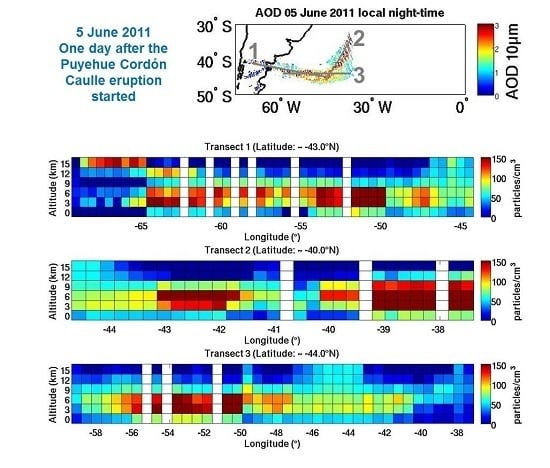Vertical Profiling of Volcanic Ash from the 2011 Puyehue Cordón Caulle Eruption Using IASI
Abstract
:1. Introduction
2. Experimental Section
2.1. Satellite Data Characteristics
2.1.1. IASI
2.1.2. CALIOP
2.2. Development of the Retrieval Algorithm and Strategy for Ash Vertical Profiles
2.2.1. The MAPIR Algorithm and Software
2.2.2. Aerosol Model Selection
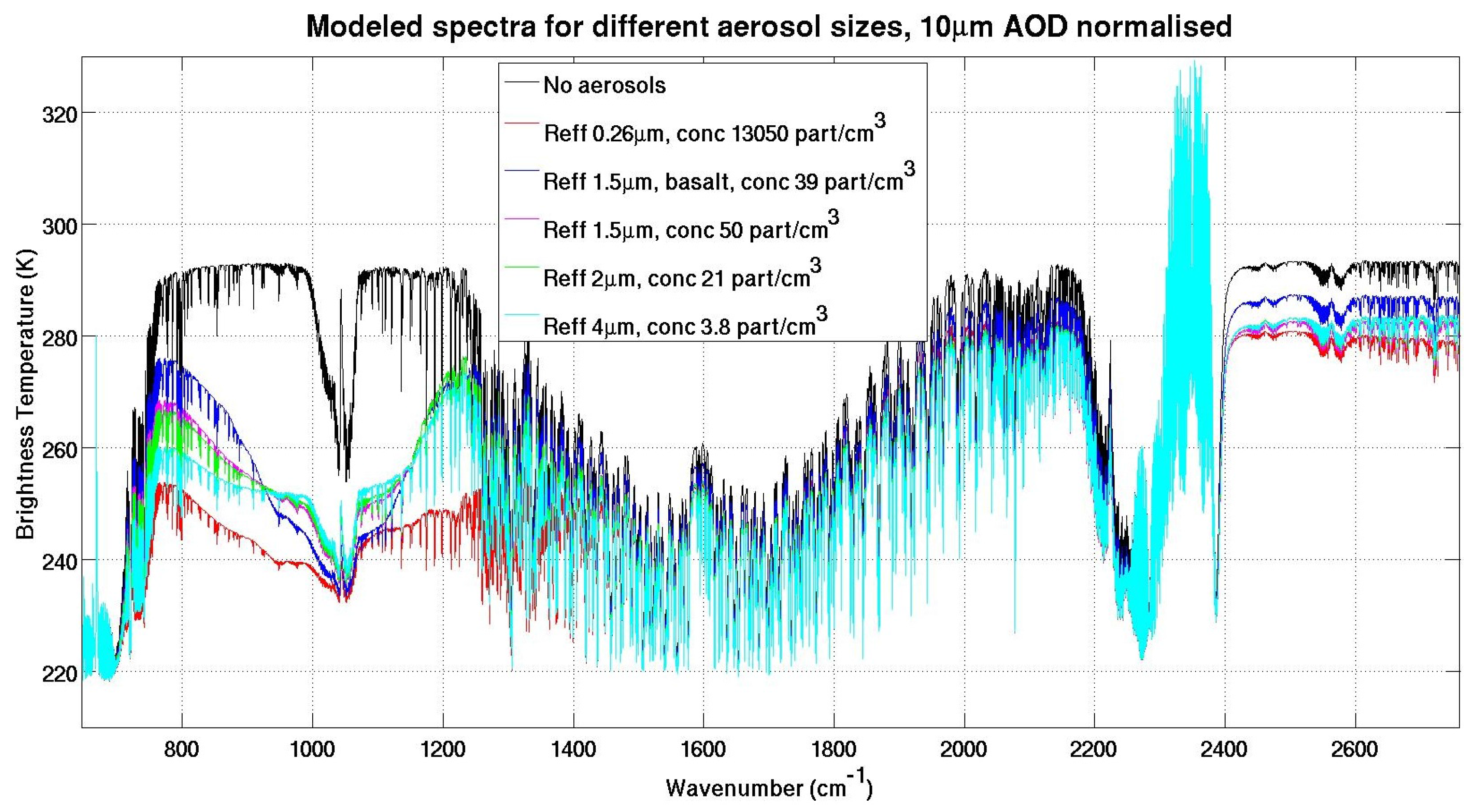
2.2.3. Retrieval Windows Selection
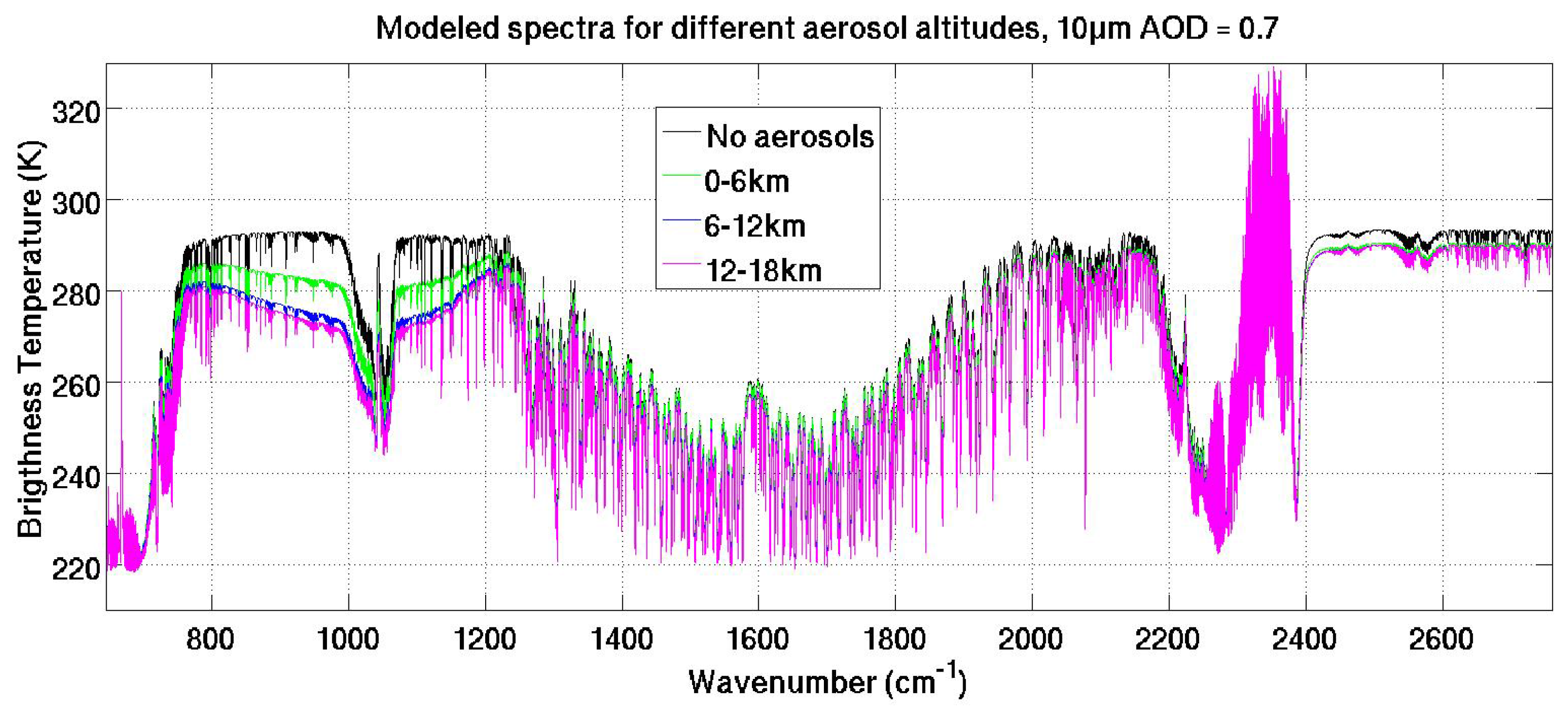
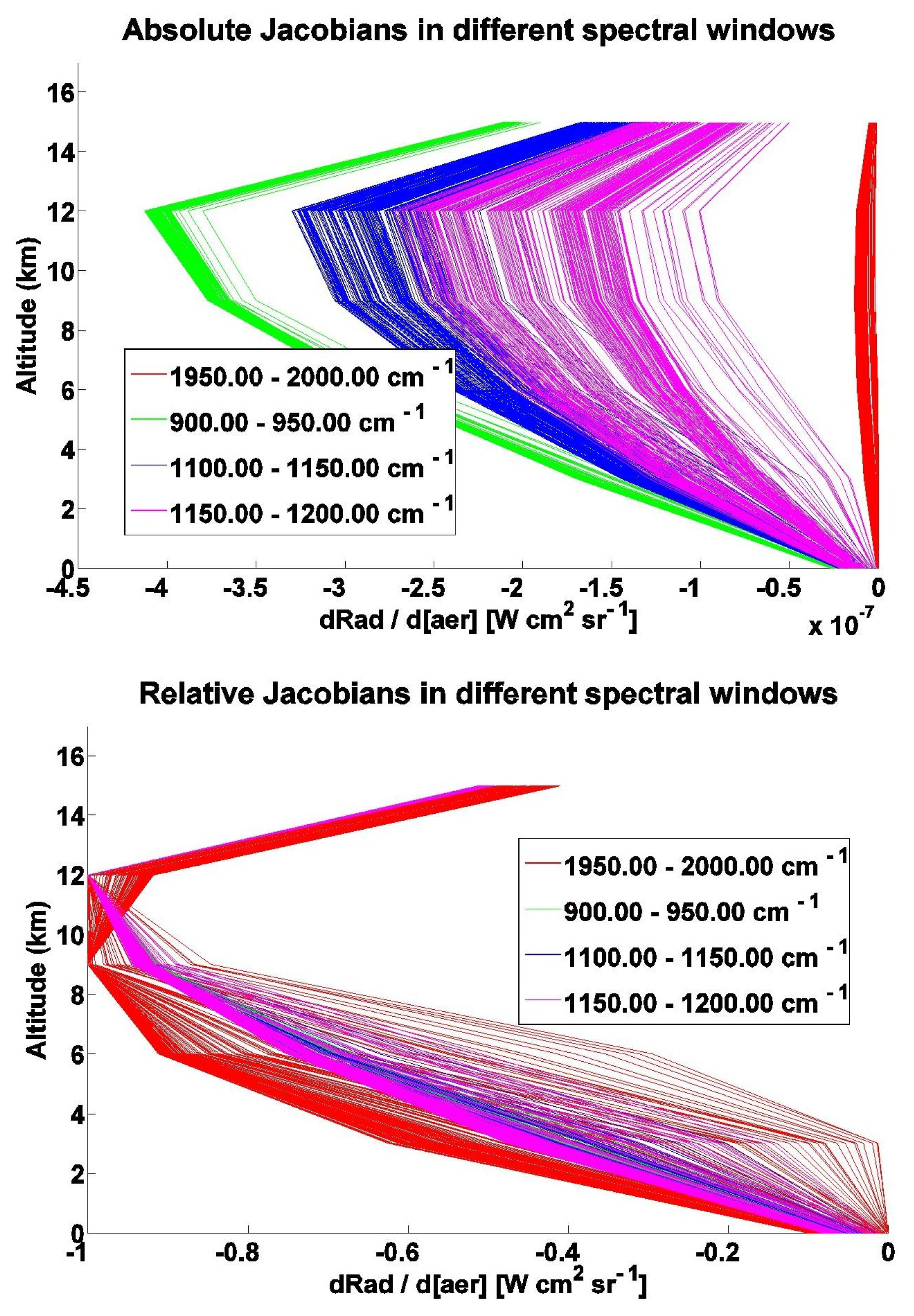
2.2.4. The Selected Retrieval Strategy
Strategy

Ancillary Data
Filters
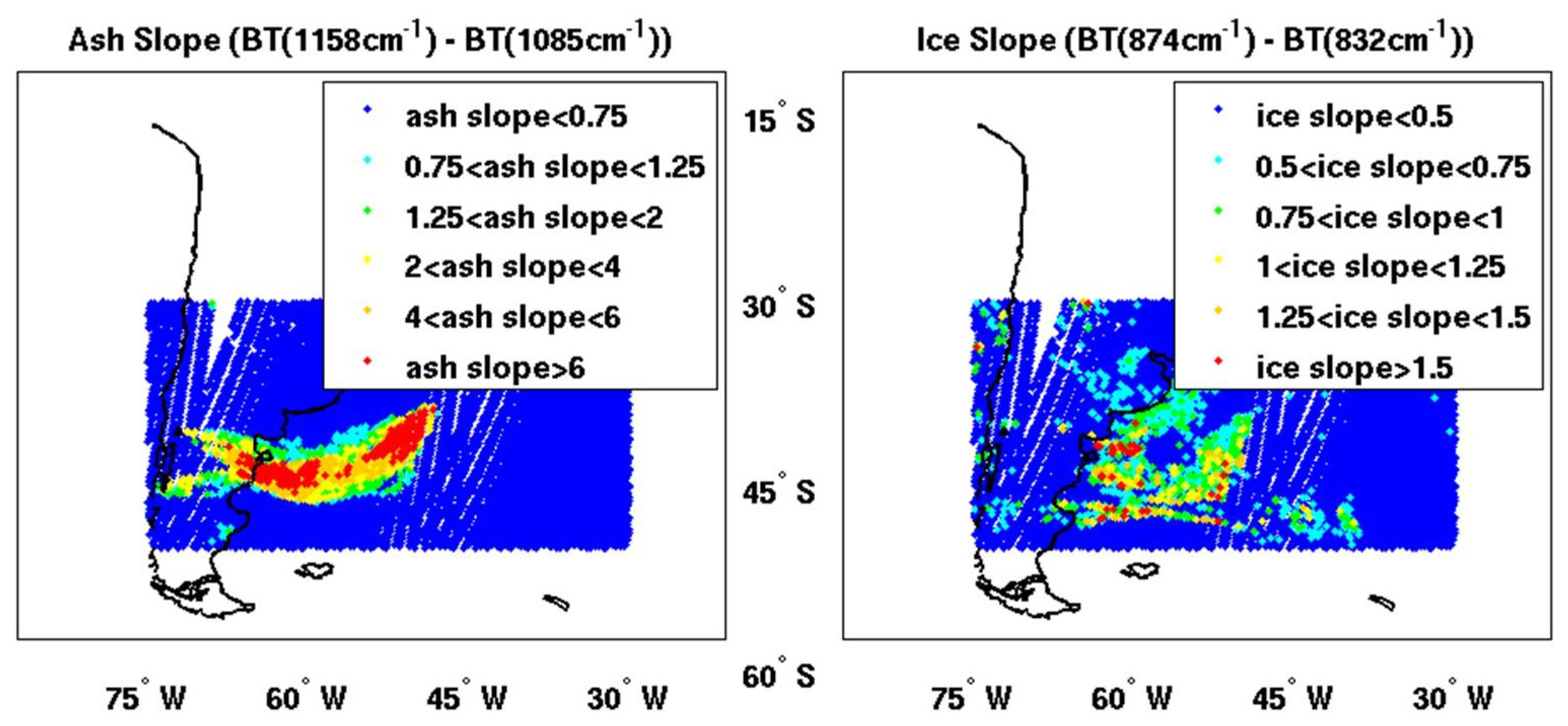
3. Results and Discussion
3.1. The IMARS Aerosol Retrieval Product as a Comparison Dataset
3.2. The Test Case: The Puyehue-Cordón Caulle Eruption in June 2011
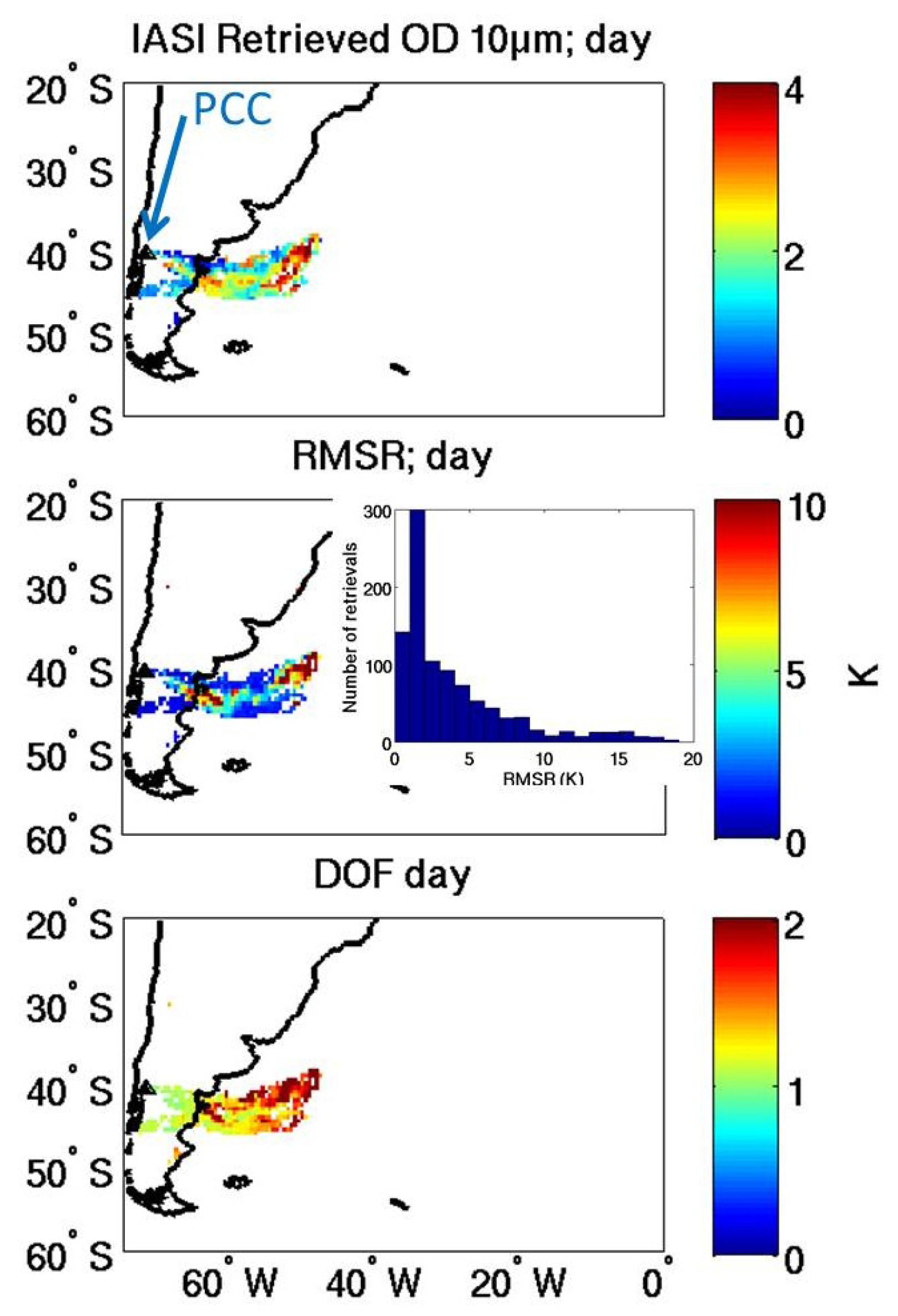
3.2.1. Detailed Analysis of Our Retrieval Results on the 5th of June
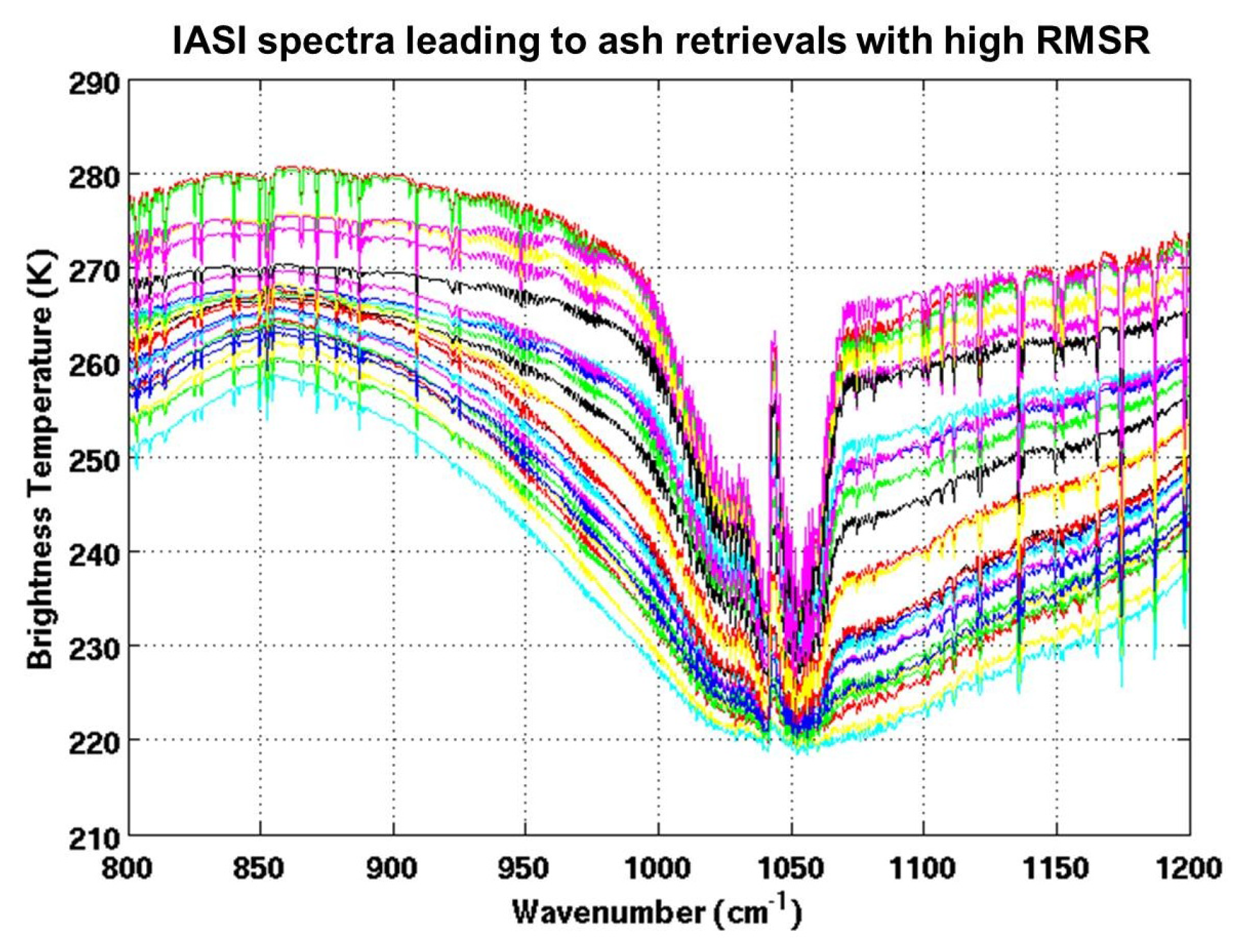
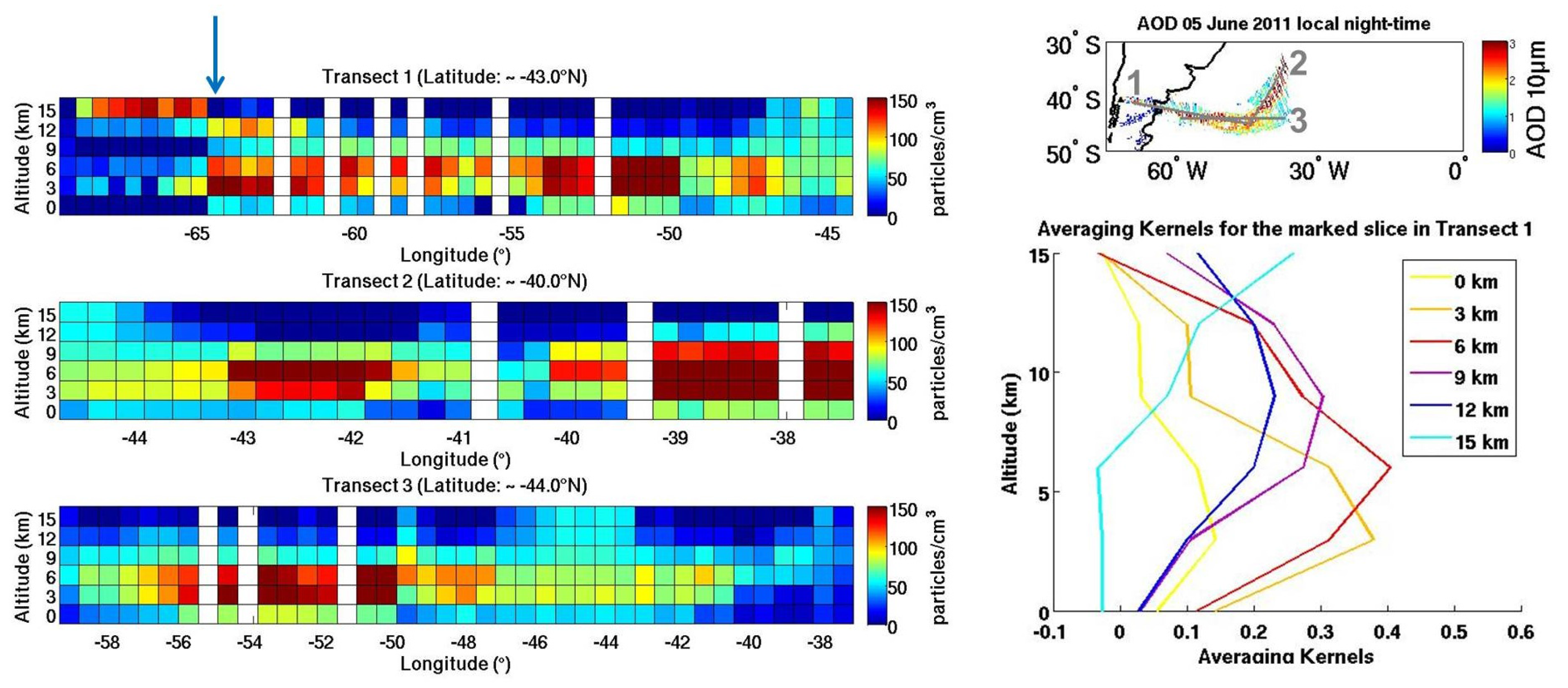
3.2.2. Comparison with the IMARS Product: 5 to 7 June 2011
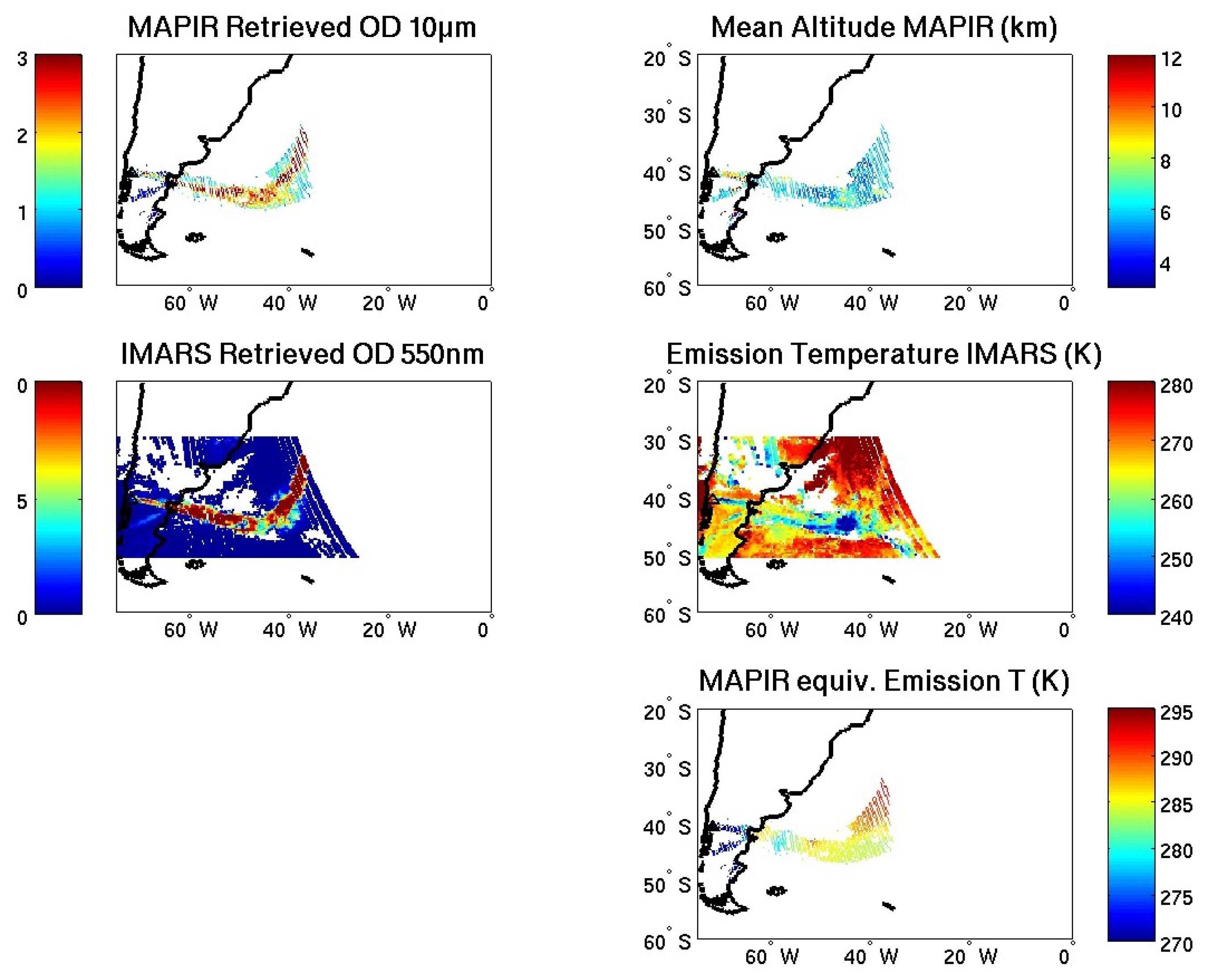
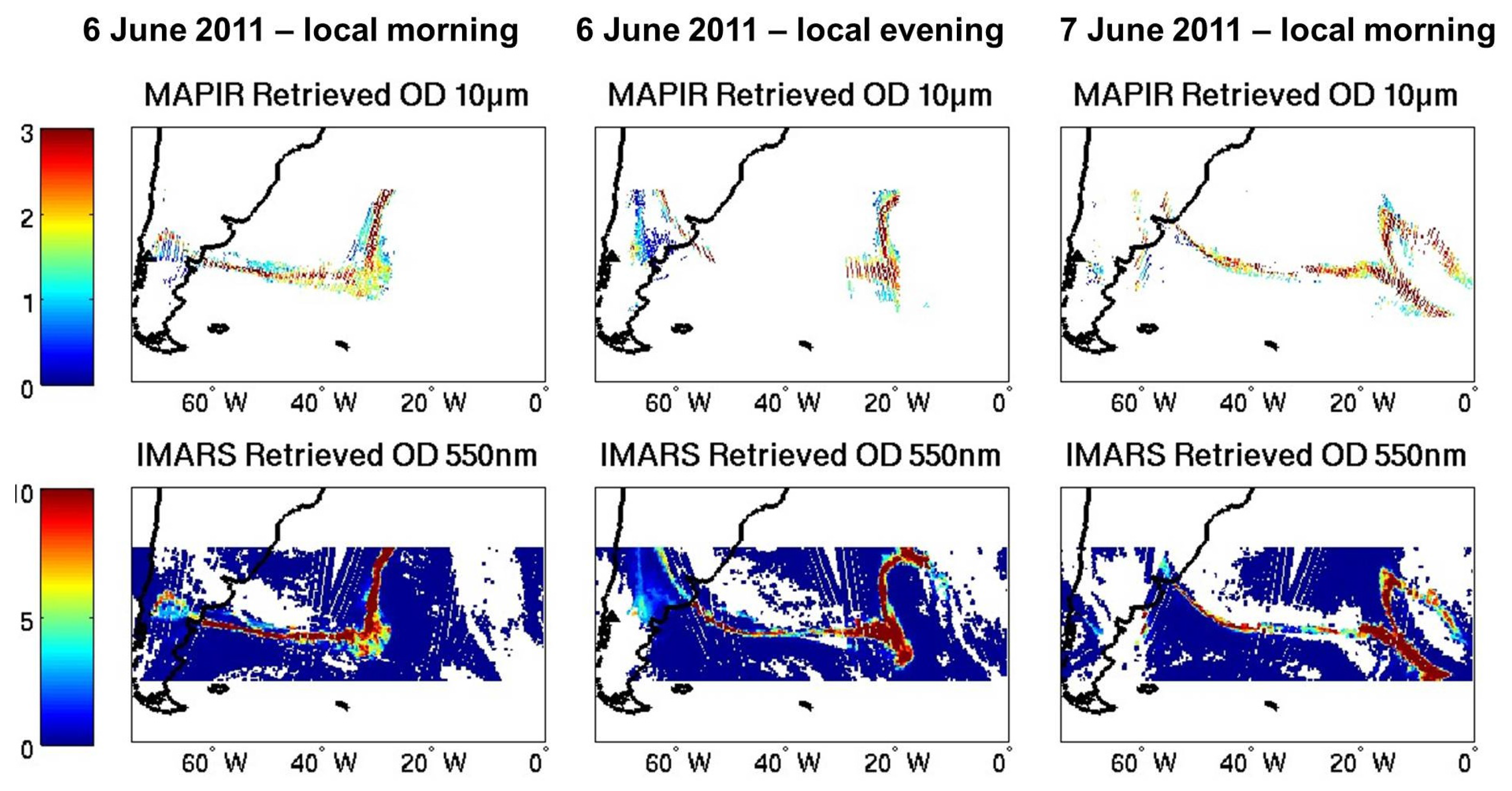
3.2.3. Comparison with CALIOP High Resolution Vertical Profiles: 16 June 2011
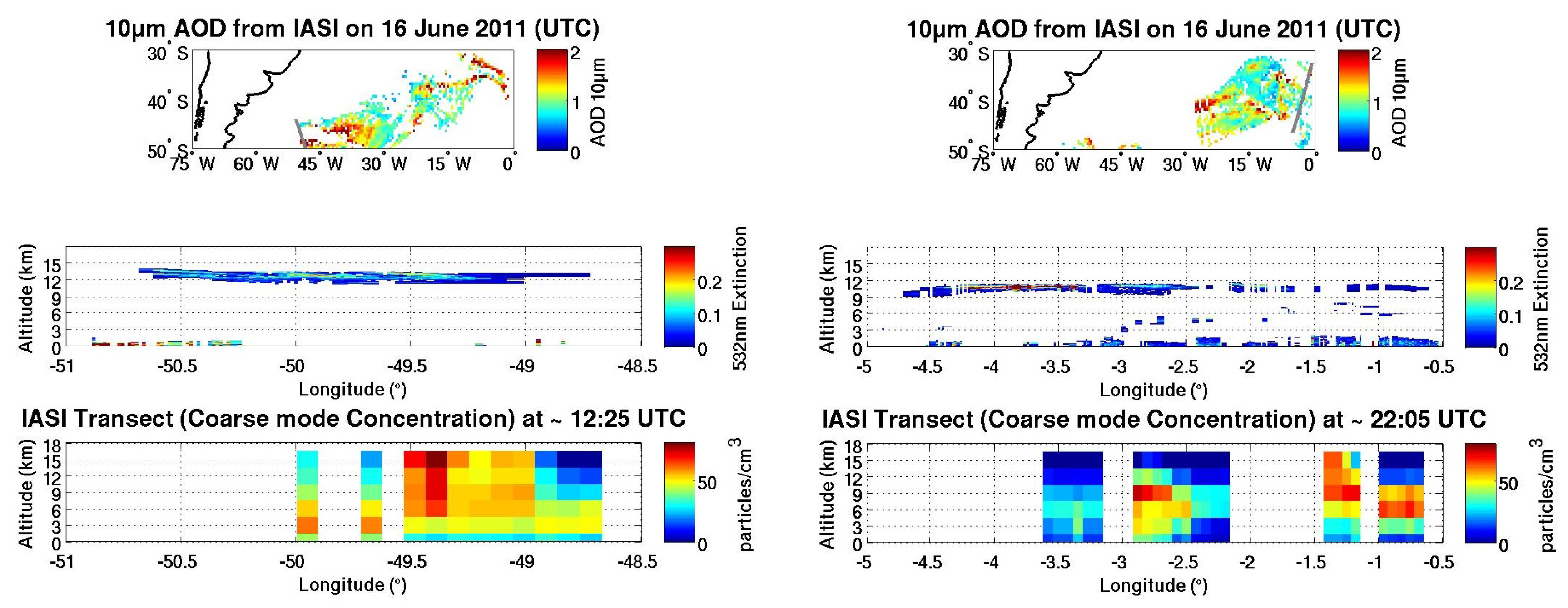
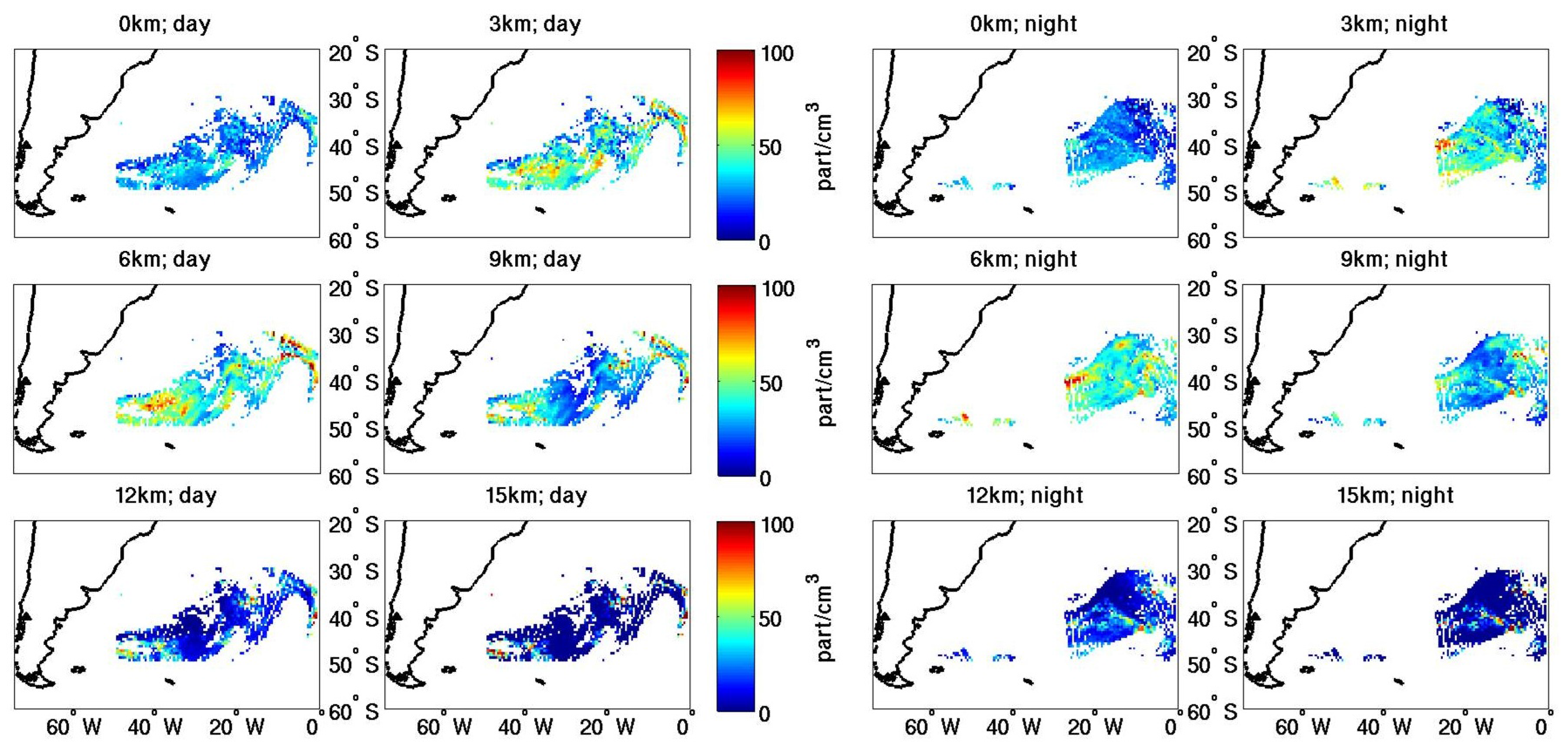
3.2.4. Retrieval Results Analysis: Full 3D View of the Plume from 5 to 7 June 2011
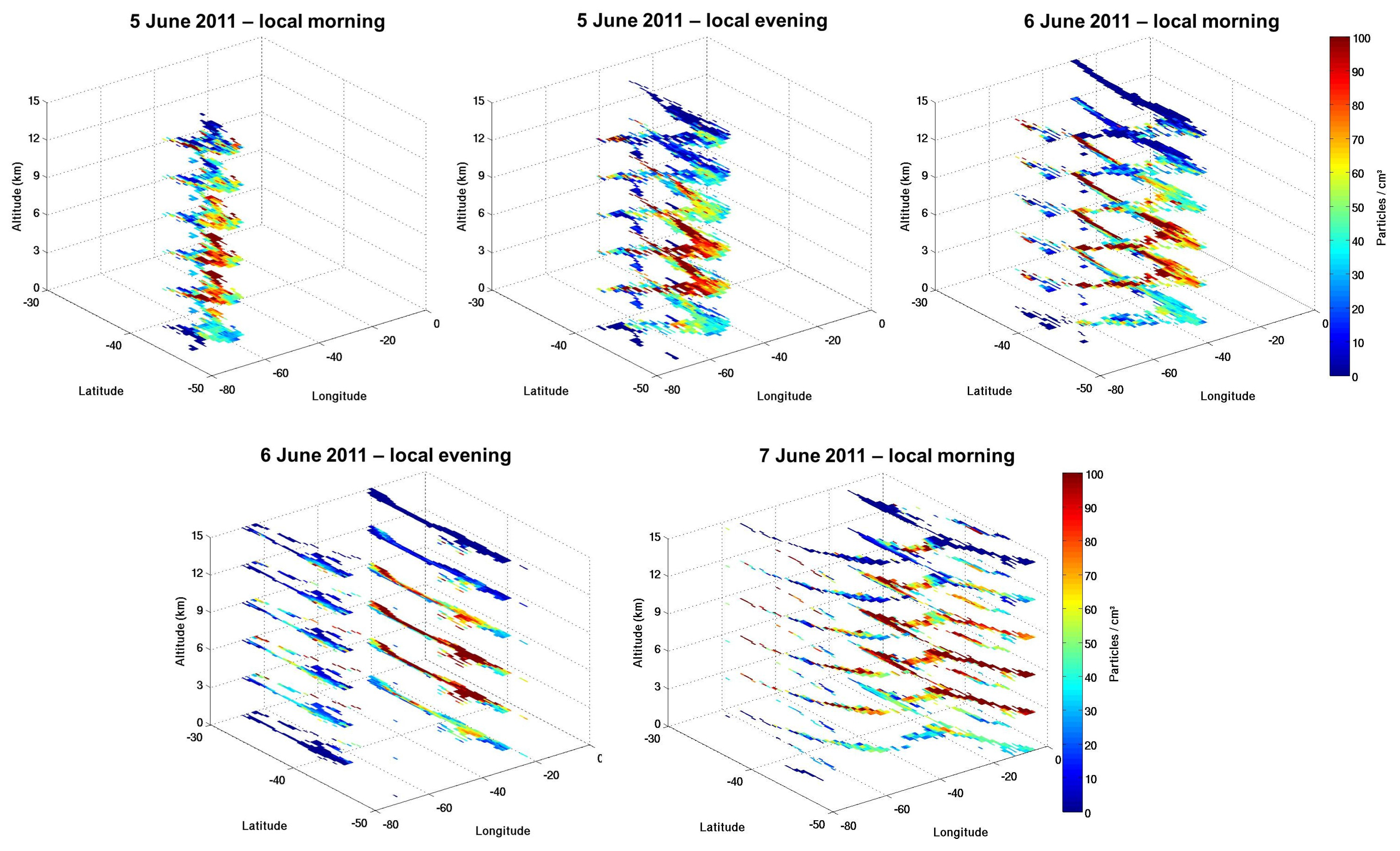
4. Conclusions
Acknowledgments
Author Contributions
Conflicts of Interest
References
- Swanson, S.E.; Beget, J. Melting properties of volcanic ash. In Proceedings of the First International Symposium on Volcanic Ash and Aviation Safety, Seattle, DC, USA, 8–12 July 1991; pp. 87–92.
- Miller, T.P.; Casadevall, T. Volcanic ash hazards to aviation. In Encyclopedia of Volcanoes; Sigurdsson, H., Ed.; Academic Press: San Diego, CA, USA, 2000; pp. 915–930. [Google Scholar]
- Prata, A. Satellite detection of hazardous volcanic clouds and the risk to global air traffic. Nat. Hazards 2009, 51, 303–324. [Google Scholar] [CrossRef]
- Zehner, C. Monitoring volcanic ash from space. In Proceedings of the ESA-EUMETSAT Workshop, Eyjafjöll Volcano, Iceland, 14 April–23 May 2010. [CrossRef]
- Haywood, J.; Boucher, O. Estimates of the direct and indirect radiative forcing due to tropospheric aerosols: A review. Rev. Geophys. 2000, 38, 513–543. [Google Scholar] [CrossRef]
- Langmann, B. Volcanic ash versus mineral dust: Atmospheric processing and environmental and climate impacts. ISRN Atmos. Sci. 2013, 2013, 245076. [Google Scholar] [CrossRef]
- Ramanathan, A.; Crutzen, P.J.; Kiehl, J.T.; Rosenfeld, D. Aerosols, climate, and the hydrological cycle. Science 2001, 294, 2119–2124. [Google Scholar] [CrossRef] [PubMed]
- Stevens, B.; Feingold, G. Untangling aerosol effects on clouds and precipitation in a buffered system. Nature 2009, 461, 607–613. [Google Scholar] [CrossRef] [PubMed]
- Myhre, G.; Shindell, D.; Bréon, F.M.; Collins, W.; Fuglestvedt, J.; Huang, J.; Koch, D.; Lamarque, J.F.; Lee, D.; Mendoza, B.; et al. Anthropogenic and natural radiative forcing. In Climate Change 2013: The Physical Science Basis; Stocker, T.F., Qin, D., Plattner, G.-K., Tignor, M., Allen, S.K., Boschung, J., Nauels, A., Xia, Y., Bex, V., Midgley, P.M., Eds.; Cambridge University Press: Cambridge, UK; New York, NY, USA, 2013; Chapter 8; pp. 659–740. [Google Scholar]
- Western, L.M.; Watson, M.I.; Francis, P.N. Uncertainty in two-channel infrared remote sensing retrievals of a well-characterised volcanic ash cloud. Bull. Volcanol. 2015, 77. [Google Scholar] [CrossRef]
- Naeger, A.R.; Christopher, S.A. The identification and tracking of volcanic ash using the Meteosat Second Generation (MSG) Spinning Enhanced Visible and Infrared Imager (SEVIRI). Atmos. Meas. Tech. 2014, 7, 581–597. [Google Scholar] [CrossRef]
- Dubuisson, P.; Herbin, H.; Minvielle, F.; Compiègne, M.; Thieuleux, F.; Parol, F.; Pelon, J. Remote sensing of volcanic ash plumes from thermal infrared: A case study analysis from SEVIRI, MODIS and IASI instruments. Atmos. Meas. Tech. 2014, 7, 359–371. [Google Scholar] [CrossRef]
- Bignami, C.; Corradini, S.; Merucci, L.; de Michele, M.; Raucoules, D.; de Astis, G.; Stramondo, S.; Piedra, J. Multisensor satellite monitoring of the 2011 Puyehue-Cordon Caulle eruption. IEEE J. Sel. Top. Appl. Earth Obs. Remote Sens. 2014, 7, 2786–2796. [Google Scholar] [CrossRef]
- Wiegner, M.; Gasteiger, J.; Gross, S.; Schnell, F.; Freudenthaler, V.; Forkel, R. Characterization of the Eyjafjallajökull ash-plume: Potential of LiDAR remote sensing. Phys. Chem. Earth. A/B/C 2012, 45–46, 79–86. [Google Scholar] [CrossRef]
- Prata, A.J.; Prata, A.T. Eyjafjallajökull volcanic ash concentrations determined using Spin Enhanced Visible and Infrared Imager measurements. J. Geophys. Res.: Atmos. 2012, 117, D00U23. [Google Scholar] [CrossRef]
- Wen, S.; Rose, W.I. Retrieval of sizes and total masses of particles in volcanic clouds using AVHRR bands 4 and 5. J. Geophys. Res.: Atmos. 1994, 99, 5421–5431. [Google Scholar] [CrossRef]
- Sears, T.M.; Thomas, G.E.; Carboni, E.; Smith, A.J.; Grainger, R.G. SO2 as a possible proxy for volcanic ash in aviation hazard avoidance. J. Geophys. Res.: Atmos. 2013, 118, 5698–5709. [Google Scholar]
- Brenot, H.; Theys, N.; Clarisse, L.; van Geffen, J.; van Gent, J.; van Roozendael, M.; van der, A.R.; Hurtmans, D.; Coheur, P.F.; Clerbaux, C.; et al. Support to Aviation Control Service (SACS): An online service for near-real-time satellite monitoring of volcanic plumes. Nat. Hazards Earth Syst. Sci. 2014, 14, 1099–1123. [Google Scholar] [CrossRef]
- Karagulian, F.; Clarisse, L.; Clerbaux, C.; Prata, A.J.; Hurtmans, D.; Coheur, P.F. Detection of volcanic SO2, ash, and H2SO4 using the Infrared Atmospheric Sounding Interferometer (IASI). J. Geophys. Res.: Atmos. 2010, 115, D00L02. [Google Scholar]
- Francis, P.N.; Cooke, M.C.; Saunders, R.W. Retrieval of physical properties of volcanic ash using Meteosat: A case study from the 2010 Eyjafjallajokull eruption. J. Geophys. Res.: Atmos. 2012, 117, D00U09. [Google Scholar] [CrossRef]
- Carboni, E.; Grainger, R.; Walker, J.; Dudhia, A.; Siddans, R. A new scheme for sulphur dioxide retrieval from IASI measurements: Application to the Eyjafjallajokull eruption of April and May 2010. Atmos. Chem. Phys. 2012, 12, 11417–11434. [Google Scholar] [CrossRef]
- Theys, N.; Campion, R.; Clarisse, L.; Brenot, H.; van Gent, J.; Dils, B.; Corradini, S.; Merucci, L.; Coheur, P.F.; van Roozendael, M.; et al. Volcanic SO2 fluxes derived from satellite data: A survey using OMI, GOME-2, IASI and MODIS. Atmos. Chem. Phys. 2013, 13, 5945–5968. [Google Scholar] [CrossRef]
- Zakšek, K.; Hort, M.; Zaletelj, J.; Langmann, B. Monitoring volcanic ash cloud top height through simultaneous retrieval of optical data from polar orbiting and geostationary satellites. Atmos. TChem. Phys. 2013, 13, 2589–2606. [Google Scholar] [CrossRef]
- Clarisse, L.; Coheur, P.F.; Theys, N.; Hurtmans, D.; Clerbaux, C. The 2011 Nabro eruption, a SO2 plume height analysis using IASI measurements. Atmos. Chem. Phys. 2014, 14, 3095–3111. [Google Scholar] [CrossRef]
- Ebmeier, S.K.; Sayer, A.M.; Grainger, R.G.; Mather, T.A.; Carboni, E. Systematic satellite observations of the impact of aerosols from passive volcanic degassing on local cloud properties. Atmos. Chem. Phys. 2014, 14, 10601–10618. [Google Scholar] [CrossRef]
- Winker, D.M.; Vaughan, M.A.; Omar, A.; Hu, Y.; Powell, K.A.; Liu, Z.; Hunt, W.H.; Young, S.A. Overview of the CALIPSO mission and CALIOP data processing algorithms. J. Atmos. Oceanic Technol. 2009, 26, 2310–2323. [Google Scholar] [CrossRef]
- Clerbaux, C.; Boynard, A.; Clarisse, L.; George, M.; Hadji-Lazaro, J.; Herbin, H.; Hurtmans, D.; Pommier, M.; Razavi, A.; Turquety, S.; et al. Monitoring of atmospheric composition using the thermal infrared IASI/MetOp sounder. Atmos. Chem. Phys. 2009, 9, 6041–6054. [Google Scholar] [CrossRef]
- Clarisse, L.; Hurtmans, D.; Prata, A.J.; Karagulian, F.; Clerbaux, C.; de Mazière, M.; Coheur, P.F. Retrieving radius, concentration, optical depth, and mass of different types of aerosols from high-resolution infrared nadir spectra. Appl. Opt. 2010, 49, 3713–3722. [Google Scholar] [CrossRef] [PubMed]
- Clarisse, L.; Coheur, P.F.; Prata, F.; Hadji-Lazaro, J.; Hurtmans, D.; Clerbaux, C. A unified approach to infrared aerosol remote sensing and type specification. Atmos. Chem. Phys. 2013, 13, 2195–2221. [Google Scholar] [CrossRef]
- Rodgers, C.D. Inverse Methods for Atmospheric Sounding—Theory and Practice; World Scientific: Singapore, 2000; Volume 2. [Google Scholar]
- Klüser, L.; Erbertseder, T.; Meyer-Arnek, J. Observation of volcanic ash from Puyehue-Cordón Caulle with IASI. Atmos. Meas. Tech. Discuss. 2012, 5, 4249–4283. [Google Scholar] [CrossRef]
- Vandenbussche, S.; Kochenova, S.; Vandaele, A.C.; Kumps, N.; de Mazière, M. Retrieval of desert dust aerosol vertical profiles from IASI measurements in the TIR atmospheric window. Atmos. Meas. Tech. 2013, 6, 2577–2591. [Google Scholar] [CrossRef]
- Vandaele, A.C.; de Mazière, M.; Drummond, R.; Mahieux, A.; Neefs, E.; Wilquet, V.; Korablev, O.; Fedorova, A.; Belyaev, D.; Montmessin, F.; et al. Composition of the Venus mesosphere measured by Solar Occultation at Infrared on board Venus Express. J. Geophys. Res. 2008, 113, E00B23. [Google Scholar] [CrossRef]
- Spurr, R. LIDORT and VLIDORT: Linearized pseudo-spherical scalar and vector discrete ordinate radiative transfer models for use in remote sensing retrieval problems. In Light Scattering Reviews 3; Kokhanovsky, A.A., Ed.; Springer: Berlin/Heidelberg, Germany, 2008; pp. 229–275. [Google Scholar]
- Mishchenko, M.I.; Dlugach, J.M.; Yanovitskij, E.G.; Zakharova, N.T. Bidirectional reflectance of flat, optically thick particulate layers: An efficient radiative transfer solution and applications to snow and soil surfaces. J. Quant. Spectrosc. Radiat. Transf. 1999, 63, 409–432. [Google Scholar] [CrossRef]
- Massie, S. Indices of refraction for the Hitran compilation. J. Quant. Spectrosc. Radiat. Transf. 1994, 52, 501–513. [Google Scholar] [CrossRef]
- Massie, S.; Goldman, A. The infrared absorption cross-section and refractive-index data in HITRAN. J. Quant. Spectrosc. Radiat. Transf. 2003, 82, 413–428. [Google Scholar] [CrossRef]
- Volz, F. Infrared refractive index of atmospheric aerosol substances. Appl. Opt. 1972, 11, 755–759. [Google Scholar] [CrossRef] [PubMed]
- Volz, F.E. Infrared optical constants of ammonium sulfate, sahara dust, volcanic pumice, and flyash. Appl. Opt. 1973, 12, 564–568. [Google Scholar] [CrossRef] [PubMed]
- Shettle, E.P.; Fenn, R.W. Models for the Aerosols of the Lower Atmosphere and the Effects of Humidity Variations on Their Optical Properties; AFGL-TR-79-0214; Optical Physics Division, Air Force Geophysics Laboratory: Hanscom AFB, MA, USA, 1979. [Google Scholar]
- Pollack, J.B.; Toon, O.B.; Khare, B.N. Optical properties of some terrestrial rocks and glasses. ICARUS 1973, 19, 372–389. [Google Scholar] [CrossRef]
- Pierangelo, C.; Mishchenko, M.; Balkanski, Y.; Chédin, A. Retrieving the effective radius of Saharan dust coarse mode from AIRS. Geophys. Res. Lett. 2005, 32, L20813. [Google Scholar] [CrossRef]
- DeSouza-Machado, S.G.; Strow, L.L.; Imbiriba, B.; McCann, K.; Hoff, R.M.; Hannon, S.E.; Martins, J.V.; Tanré, D.; Deuzé, J.L.; Ducos, F.; et al. Infrared retrievals of dust using AIRS: Comparisons of optical depths and heights derived for a North African dust storm to other collocated EOS A-Train and surface observations. J. Geophys. Res. 2010, 115, D15201. [Google Scholar] [CrossRef]
- Singer, B.; Jicha, B.; Harper, M.; Naranjo, J.; Lara, L.; Moreno-Roa, H. Eruptive history, geochronology, and magmatic evolution of the Puyehue-Cordón Caulle volcanic complex, Chile. Geol. Soc. Am. Bull. 2008, 120, 599–618. [Google Scholar] [CrossRef]
- Klüser, L.; Martynenko, D.; Holzer-Popp, T. Thermal infrared remote sensing of mineral dust over land and ocean: A spectral SVD based retrieval approach for IASI. Atmos. Meas. Tech. 2011, 4, 757–773. [Google Scholar] [CrossRef]
- Klüser, L.; Banks, J.; Martynenko, D.; Bergemann, C.; Brindley, H.; Holzer-Popp, T. Information content of space-borne hyperspectral infrared observations with respect to mineral dust properties. Remote Sens. Environ. 2015, 156, 294–309. [Google Scholar] [CrossRef]
- Newman, S.M.; Smith, J.A.; Glew, M.D.; Rogers, S.M.; Taylor, J.P. Temperature and salinity dependence of sea surface emissivity in the thermal infrared. Q. J. R. Meteorol. Soc. 2005, 131, 2539–2557. [Google Scholar] [CrossRef]
- Zhou, D.; Larar, A.; Liu, X.; Smith, W.; Strow, L.; Yang, P.; Schlussel, P.; Calbet, X. Global Land Surface Emissivity Retrieved From Satellite Ultraspectral IR Measurements. IEEE Trans. Geosci. Remote Sens. 2011, 49, 1277–1290. [Google Scholar] [CrossRef]
- August, T.; Klaes, D.; Schlüssel, P.; Hultberg, T.; Crapeau, M.; Arriaga, A.; O’Carroll, A.; Coppens, D.; Munro, R.; Calbet, X. IASI on MetOp-A: Operational Level 2 retrievals after five years in orbit. J. Quant. Spectrosc. Radiat. Transf. 2012, 113, 1340–1371. [Google Scholar] [CrossRef]
- Anderson, G.P.; Clough, S.A.; Kneizys, F.; Chetwynd, J.H.; Shettle, E.P. AFGL Atmospheric Constituent Profiles (0–120 km); Environmental Research Papers No. 954; Air Force Geophysics Laboratory: Hanscom AFB, MA, USA, 1986. [Google Scholar]
- Pavolonis, M.J.; Heidinger, A.K.; Sieglaff, J. Automated retrievals of volcanic ash and dust cloud properties from upwelling infrared measurements. J. Geophys. Res.: Atmos. 2013, 118, 1–23. [Google Scholar] [CrossRef]
- Bantges, R.; Russell, J.; Haigh, J. Cirrus cloud top-of-atmosphere radiance spectra in the thermal infrared. J. Quant. Spectrosc. Radiat. Transf. 1999, 63, 487–498. [Google Scholar] [CrossRef]
© 2016 by the authors; licensee MDPI, Basel, Switzerland. This article is an open access article distributed under the terms and conditions of the Creative Commons by Attribution (CC-BY) license (http://creativecommons.org/licenses/by/4.0/).
Share and Cite
Maes, K.; Vandenbussche, S.; Klüser, L.; Kumps, N.; De Mazière, M. Vertical Profiling of Volcanic Ash from the 2011 Puyehue Cordón Caulle Eruption Using IASI. Remote Sens. 2016, 8, 103. https://doi.org/10.3390/rs8020103
Maes K, Vandenbussche S, Klüser L, Kumps N, De Mazière M. Vertical Profiling of Volcanic Ash from the 2011 Puyehue Cordón Caulle Eruption Using IASI. Remote Sensing. 2016; 8(2):103. https://doi.org/10.3390/rs8020103
Chicago/Turabian StyleMaes, Kwinten, Sophie Vandenbussche, Lars Klüser, Nicolas Kumps, and Martine De Mazière. 2016. "Vertical Profiling of Volcanic Ash from the 2011 Puyehue Cordón Caulle Eruption Using IASI" Remote Sensing 8, no. 2: 103. https://doi.org/10.3390/rs8020103
APA StyleMaes, K., Vandenbussche, S., Klüser, L., Kumps, N., & De Mazière, M. (2016). Vertical Profiling of Volcanic Ash from the 2011 Puyehue Cordón Caulle Eruption Using IASI. Remote Sensing, 8(2), 103. https://doi.org/10.3390/rs8020103





